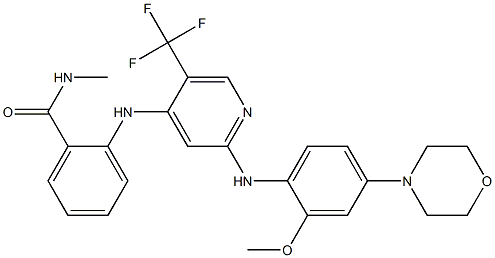


|


| 产地 | 中国 |
| 品牌 | Chemstan |
| 货号 | LC-01 |
| 用途 | 中间体 |
| 包装规格 | 20mg |
| 纯度 | 98%% |
| CAS编号 | 1061353-68-1 |
| 是否进口 | 否 |
联合知名大学科研院所及企业开发药食两用植物标准品和天然植物有效单体,主打中药对照品/标准品/天然植物有效单体,小分子化合物库,药物杂质。所有产品仅用作科学研究,我们不为任何个人用途提供产品和服务。
Fields of Application :
PND-1186 is a potent FAK inhibitor with IC50 of 1.5 nM.
| CAS Number: | 1061353-68-1 |
| Purity: | >98% |
| Molecular Weight: | 501.5 |
| Molecular Formula: | C25H26F3N5O3 |
Quality Control: HPLC、NMR、 LC/MS(Please contact us to get the QC report)
| Synonyms: | SR-2516; PND 1186; PND1186; SR 2516; SR2516 |
| Chemical Name: | 2-((2-((2-methoxy-4-morpholinophenyl)amino)-5-(trifluoromethyl)pyridin-4-yl)amino)-N-methylbenzamidehydrochloride. |
| Storage: | 2 years -20°C Powder, 2 weeks4°C in DMSO,6 months-80°C in DMSO |
Note: Products for research use only, not for human use
Description:
PND-1186, also known as SR-2156, is a potent FAK inhibitor with a 50% inhibitory concentration (IC50) of 1.5 nM in vitro. PND-1186 has an IC50 of ~100 nM in breast carcinoma cells. Notably, 1.0 μM PND-1186 (>5-fold above IC50) had limited effects on cell proliferation. However, under non-adherent conditions as spheroids and as colonies in soft agar, 0.1 μM PND-1186 blocked FAK and p130Cas tyrosine phosphorylation, promoted caspase-3 activation, and triggered cell apoptosis. PND-1186 inhibited 4T1 breast carcinoma subcutaneous tumor growth correlated with elevated tumor cell apoptosis and caspase 3 activation. Addition of PND-1186 to the drinking water of mice was well tolerated and inhibited ascites- and peritoneal membrane-associated ovarian carcinoma tumor growth associated with the inhibition of FAK Tyr-397 phosphorylation.For the detailed information of PND-1186, the solubility of PND-1186 in water, the solubility of PND-1186 in DMSO, the solubility of PND-1186 in PBS buffer, the animal experiment (test) of PND-1186, the cell expriment (test) of PND-1186, the in vivo, in vitro and clinical trial test of PND-1186, the EC50, IC50,and Affinity of PND-1186.
References:
CNC(=O)C1=CC=CC=C1NC2=CC(=NC=C2C(F)(F)F)NC3=C(C=C(C=C3)N4CCOCC4)OC